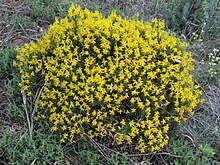게니스토이드
Genistoids| 게니스토이드 | |
|---|---|
 | |
| 제니스타 히르수타 | |
| 과학적 분류 | |
| 킹덤: | 플랜태 |
| 클래드: | 기관지동물 |
| 클래드: | 안기오스페름스 |
| 클래드: | 에우디코츠 |
| 클래드: | 로시즈 |
| 순서: | 파발레스 |
| 패밀리: | 파브과 |
| 하위 패밀리: | 파부아과 |
| 클래드: | 메소파필리오네아과 |
| 클래드: | 게니스토이드 Wojciechowski 등. 2004[1][2] |
| 부족[7][8] | |
| 동의어 | |
| |
Genistoids는 식물군 파브과에서 주요한 방사선의 하나이다. 이 혈전성 쇄골의 구성원들은 주로 남반구에서 발견된다.[1][7][8] 몇몇 제네라는 새에 의해 수분된다.[7] 게니스토이드 클라드는 분자 계통생성 분석에서 단극성으로 일관되게 해결된다.[1][7][8][10][11][12][13][14] 56.4 ± 0.2만년 전에 (팔레오세에서) 발생한 것으로 추정된다.[11] 게니스토이드에 대한 노드 기반 정의는 "Poecilanthe parviflora와 Lupinus argenteus의 MRCA"[1]이다. 하나의 형태론적 시나포모피(morphological synapomorphy)가 잠정적으로 확인되었다: 키놀리지딘 알칼로이드의 생산이다.[1][15][16][17] 일부 제네랄은 피롤리지딘을 축적하기도 한다.[7][8] 클라트로피스와 분리될 새로운 속은 또한 게니스토이드 쇄도 내에서 결정되지 않은 위치를 차지하도록 제안되었다.[7][8]
코어 게니스토이드
'게니스토이드 센슈 엄격한'이라고도 알려진 핵심 게니스토이드들은 게니스토이드 센슈 라토 부족의 대부분을 차지하고 있으며 주로 아프리카와 유라시아에서 발견된다.[8] 이 하위 표지는 또한 단극성으로 일관성 있게 해결된다.[1][7][8][3][10][11][12] 핵심 게니스토이드에 대한 노드 기반 정의는 다음과 같다: "볼루산투스 스펙티오소스와 스파르티움 융체의 MRCA."[1]
계통학
현대의 분자 계통유전학은 다음과 같은 관계를 제안한다.[4][6][8]
| |||||||||||||||||||||||||||||||||||||||||||||||||||||||||||||||||||||||||||||||
참조
- ^ a b c d e f g Wojciechowski MF, Lavin M, Sanderson MJ (2004). "A phylogeny of legumes (Leguminosae) based on analysis of the plastid matK gene resolves many well-supported subclades within the family". Am J Bot. 91 (11): 1846–1862. doi:10.3732/ajb.91.11.1846. PMID 21652332.
- ^ Wojciechowski MF (2013). "Towards a new classification of Leguminosae: Naming clades using non-Linnaean phylogenetic nomenclature". S Afr J Bot. 89: 85–93. doi:10.1016/j.sajb.2013.06.017.
- ^ a b Crisp MD, Gilmore S, Van Wyk B-E (2000). "Molecular phylogeny of the genistoid tribes of papilionoid legumes". In Herendeen PS, Bruneau A (eds.). Advances in Legume Systematics, Part 9. Royal Botanic Gardens, Kew. pp. 249–276. ISBN 978-1842460177.
- ^ a b Cardoso D, Harris DJ, Wieringa JJ, São-Mateus WMB, Batalha-Filho H, Torke BM, Prenner G, de Queiroz LP (2017). "A molecular-dated phylogeny and biogeography of the monotypic legume genus Haplormosia, a missing African branch of the otherwise American-Australian Brongniartieae clade". Molecular Phylogenetics and Evolution. 107: 431–442. doi:10.1016/j.ympev.2016.12.012. PMID 27965083.
- ^ Swanepoel W, le Roux MM, Wojciechowski MF, van Wyk AE (2015). "Oberholzeria (Fabaceae subfam. Faboideae), a New Monotypic Legume Genus from Namibia". PLOS ONE. 10 (3): e0122080. Bibcode:2015PLoSO..1022080S. doi:10.1371/journal.pone.0122080. PMC 4376691. PMID 25816251.
- ^ a b Castellanos C, Lewis GP, Banks H, Steeves R, Bruneau A (2016). "A settled sub-family for the orphan tree: The phylogenetic position of the endemic Colombian genus Orphanodendron in the Leguminosae". Brittonia. 69: 1–9. doi:10.1007/s12228-016-9451-3. S2CID 43040112.
- ^ a b c d e f g Cardoso D, de Queiroz LP, Pennington RT, de Lima HC, Fonty É, Wojciechowski MF, Lavin M (2012). "Revisiting the phylogeny of papilionoid legumes: new insights from comprehensively sampled early-branching lineages". Am J Bot. 99 (12): 1991–2013. doi:10.3732/ajb.1200380. PMID 23221500.
- ^ a b c d e f g h Cardoso D, Pennington RT, de Queiroz LP, Boatwright JS, Van Wyk B-E, Wojciechowski MF, Lavin M (2013). "Reconstructing the deep-branching relationships of the papilionoid legumes". S Afr J Bot. 89: 58–75. doi:10.1016/j.sajb.2013.05.001.
- ^ Polhill RM (1981). "Papilionoideae". In Polhill RM, Raven PH (eds.). Advances in Legume Systematics, Parts 1 and 2. Royal Botanic Gardens, Kew. pp. 191–208. ISBN 9780855212247.
- ^ a b LPWG [Legume Phylogeny Working Group] (2013). "Legume phylogeny and classification in the 21st century: progress, prospects and lessons for other species-rich clades" (PDF). Taxon. 62 (2): 217–248. doi:10.12705/622.8. hdl:10566/3455.
- ^ a b c Lavin M, Herendeen PS, Wojciechowski MF (2005). "Evolutionary rates analysis of Leguminosae implicates a rapid diversification of lineages during the tertiary". Syst Biol. 54 (4): 575–94. doi:10.1080/10635150590947131. PMID 16085576.
- ^ a b McMahon MM, Sanderson MJ (2006). "Phylogenetic supermatrix analysis of GenBank sequences from 2228 papilionoid legumes". Syst Biol. 99 (12): 1991–2013. doi:10.1080/10635150600999150. PMID 17060202.
- ^ Pennington RT, Lavin M, Ireland H, Klitgaard B, Preston J, Hu JM (2001). "Phylogenetic relationships of basal papilionoid legumes based upon sequences of the chloroplast trnL intron". Syst Bot. 55 (5): 818–836. doi:10.1043/0363-6445-26.3.537 (inactive 31 October 2021).
{{cite journal}}: CS1 maint : 2021년 10월 현재 DOI 비활성화(링크) - ^ Doyle JJ, Doyle JL, Ballenger JA, Dickson EE, Kajita T, Ohashi H (1997). "A phylogeny of the chloroplast gene rbcL in the Leguminosae: taxonomic correlations and insights into the evolution of nodulation". Am J Bot. 84 (4): 541–554. doi:10.2307/2446030. JSTOR 2446030. PMID 21708606.
- ^ Kinghorn AD, Hussain RA, Robbins EF, Balandrin MF, Stirton CH, Evans SV (1988). "Alkaloid distribution in seeds of Ormosia, Pericopsis and Haplormosia". Phytochemistry. 27 (2): 439–444. doi:10.1016/0031-9422(88)83116-9.
- ^ Van Wyk B-E. (2003). "The value of chemosystematics in clarifying relationships in the Genistoid tribes of papilionoid legumes". Biochem Syst Ecol. 31 (8): 875–884. doi:10.1016/S0305-1978(03)00083-8.
- ^ Wink M, Mohamed GI (2003). "Evolution of chemical defense traits in the Leguminosae: mapping of distribution patterns of secondary metabolites on a molecular phylogeny inferred from nucleotide sequences of the rbcL gene". Biochem Syst Ecol. 31 (8): 897–917. doi:10.1016/S0305-1978(03)00085-1.

